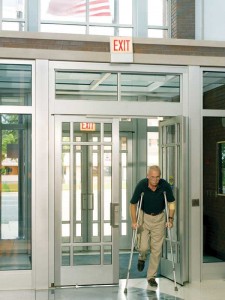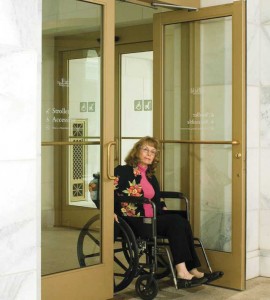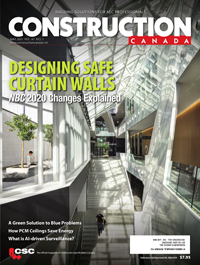A Balance Of Power: How power-operated balanced doors provide ultimate accessibility

a consistently fluid mechanical opening and closing operation. The unique design of a balanced door ensures fluidity during powered or manual operation, while protecting electronic mechanisms with its solid construction.
As a balanced door has a more equalized weight distribution, its size, weight, and durability is rendered inconsequential to the ease of opening during manual operation. This occurs because air pressures work with the door (rather than against it), resulting in minimal required pulling force. In other words, when a balanced door is pulled against the forces of air, its entire surface area is not negatively impacted as it is with a conventional door. The air pressure will affect both the strike side and the hinged side (on both sides of the fulcrum), using some of the air’s force to assist in opening the door. The same is true when the door closes, allowing for a faster and more energy-efficient closing motion.
Some balanced door manufacturers offer a unique concealed power-operation mechanism that, in addition to numerous other benefits, creates an easier power-operation to manual-operation transition. One type of power-operation mechanism conceals the entire system within a balanced door’s header, only revealing a sleek actuating arm when the door is open. This option is much more attractive than using unsightly tacked-on surface-mounted power operators, and leaves the system unexposed to the elements. Unlike floor-mounted operators, which are also concealed, overhead concealed operators protect the electronic components from damaging water leaked in by rain or cleaning.
This type of overhead concealed power-operator is designed such that the actuating arm is not attached to the door. When power operation is selected by the user (from a wall- or post-mounted switch), the door powers open immediately, remaining ajar for a predetermined time, allowing for comfortable passage. When it is time for the door to close, the unattached actuating arm precedes the door’s motion into its rest position directly above the door, and is hidden by the header door stop. This allows the door’s standard closer spring to close it independently of the arm. The door’s next user is then free to operate manually without involving the power system, even if the door has not fully closed. This translates to time savings, energy savings, and protection of the power hardware.
Emergency safety and energy efficiency
A power-operated balanced door system provides critical advantages for building safety. Instead of relying on manual push-operation during quick evacuation, power-operation allows occupants to focus solely on safely exiting a facility through an open door.

Power operation can even be functionally synched to a building’s emergency control system so when triggered (e.g. by a fire pull-station or a security desk mechanism), the door automatically powers open and remains at its 90-degree hold-open position until manually reset. This facilitates safe human traffic and requires little or no manual operation, which is useful in an emergency situation. In the case of a fire, this system also provides continuous external transfer of smoke and influx of makeup air—a safety requirement mandated by many provincial building codes.
Owing to the solid construction of a balanced door, a power-operated entry system of this kind is extremely durable. With a conventional door, the system’s entire weight is hung off the frame, including bulky surface-mounted power-operators. Over time, screw holes elongate, causing screws to come loose and the door to pull away, resulting in sag and drag. With a balanced door, the leaf is not connected to the frame, so the door’s weight is transferred to the bottom arm, down to the floor box, and eventually down to the floor, which is much more capable of bearing weight than metal hinges.
Likewise, the power-operating actuating arm is not connected to the frame, and is therefore not worn down by manual operation. For these reasons, a balanced door system lasts much longer than a conventional hinged system, and much better suits power operation.
The overhead concealed power-operator found in some balanced doors is considered a low-energy operator, which helps to satisfy building codes without the need for additional safety devices required for high-energy operators, saving construction time, money, and energy. Unlike other power options, like sliding doors, a balanced door only opens when prompted and closes consistently and fully, without flutter or unintended re-opening. If operated manually, the door need not use electricity at all, resulting in huge energy savings over a facility’s lifetime. Also, unlike sliding doors, manual operation will not be inhibited in the case of electronic failure, avoiding the headache of an inaccessible entry system before repair.
Furthermore, a power-operated balanced door can be superior to powered sliding doors in retrofit construction or for building in tight spaces because the doors do not require extra lateral space for recessing. All extra space requirements for a balanced door are vertical (to accommodate for the concealed power components in the header) or, in small part, depth into the facility (to accommodate for the internal leaf projection). These extensions are typically much easier to make room for, especially when fitting a new door into the space of a previous entry system.
Solid investment in the future
For specifiers of any new or retrofit construction project, universal accessibility needs to be a priority to build a successful, functional facility for the long term. Power operation is a worthwhile investment in usability, code adherence, and meeting real, physical needs. A balanced door offers a durable and sustainable encasement of this investment. The system offers an attractive and functionally complementary design. This type of entryway is ideal for any high-traffic facility or any building intended to last a long time. After all, to serve its purpose, a door must be accessible.
Mark Graves is the president of Ellison Bronze Inc. He has more than 30 years of experience in the general construction, architecture, and manufacturing industries. Graves has spent 25 years of his career manufacturing custom balanced doors with Ellison. He can be reached via e-mail at mgraves@ellisonbronze.com.







